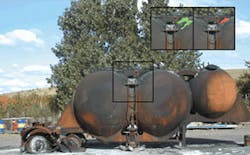Detecting gas leaks is important at chemical factories and pipelines, at the scenes of gas-tanker accidents, and around air inlets and outlets in indoor work areas. Geologists also like to study emissions from volcanoes or mines, and other scientists need information about the greenhouse gases emitted by farms and swamps. Jonas Sandsten and his colleagues at the Lund Institute of Technology (Lund, Sweden) have developed a method of imaging gas leaks in real time using ambient temperatures and an infrared (IR) camera. They say this passive method is better for real-time imaging of emissions than techniques using lidar, which they consider more limited in range and imaging capabilities.
Key to the technique is use of a gas-correlation cell, which acts as a filter to the stronger absorption lines of the gas it is filled with. By comparing an image taken through the correlation cell to the same image without the cell, the researchers can verify that the gas they're looking for is in fact the gas they're seeing (see image).
Sandsten's team set up an experiment that used a burnt-out, rusty gas tank. The measurements were made in southern Sweden in September, with mostly sunny conditions and an ambient air temperature of 18°C to 21°C. The tanker provided a background with a surface temperature of 30°C to 40°C and an emissivity of 0.9. Researchers attached tubes to the tanker, which ran to bottles containing ammonia, ethylene, and methane, to simulate gas leaks.
The detector, placed 20 m away, consisted of a Cassegrain split-mirror telescope with a total receiving area of 2 x 10 cm2, two primary spherical aluminum mirrors, and a secondary spherical aluminum mirror. The IR camera had a low noise-equivalent temperature difference of 80 mK and a maximum relative spectral response at 11 µm, chosen because the gases the team was looking for have unique spectral properties in the 3- to 13-µm region. For measuring gases with absorption around 10 µm, they used zinc selenide with an antireflection coating to make the windows for the gas-correlation cell. For gases with absorption around 8 µm, they used calcium fluoride.
The telescope took in two simultaneous images, one passed through the correlation cell and one without it. The images were passed to the IR camera, equipped with interference filters on a filter wheel, which then fed them to a PC. A frame grabber allowed the PC to record real-time images at 12 bits, 272 x 136 pixels, and 15 frames/s. A separate charge-coupled-device camera recorded the whole scene in visible light. The computer overlaid the images and processed them to create a movie showing the gas leak. With this setup, Sandsten's team was able to detect down to 220 parts per million of ammonia when the temperature difference between the background and the gas leak was 18°C.
The researchers say that it should be possible not only to detect leaks but to measure the amount of gas escaping, although that requires knowing the temperature difference between the gas and the background. They have recently developed a new telescope that improves the sensitivity and image quality and plan to test it under varying weather conditions. A camera sensitive in the 8- to 14-µm region would make it possible to monitor several gases. "We will explore the possibility of monitoring other gases, especially hydrocarbon emissions from petrochemical factories," Sandsten said.
They even picture a detector that could be carried aboard a helicopter to monitor pipelines. The fact that the two images are captured exactly simultaneously eliminates any problems from motion of the detector.
About the Author
Neil Savage
Associate Editor
Neil Savage was an associate editor for Laser Focus World from 1998 through 2000.
